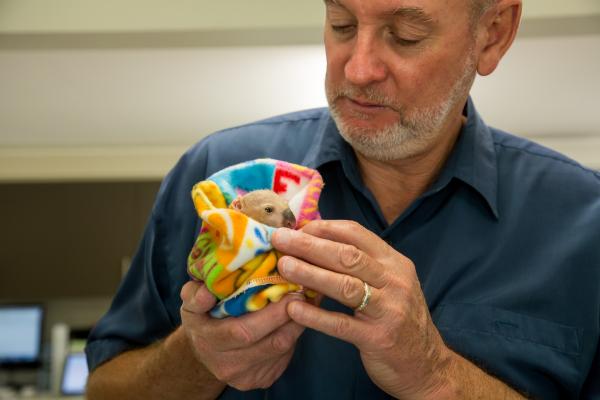If you haven’t got a tree nothing else matters, Professor Peter Timms said of koalas whose declining populations from habitat loss are also the result of car strikes and dog attacks but it is the diseases they have that most interests the microbiologist.
The University of the Sunshine Coast (USC) professor has long been researching a vaccine for the two most prevalent and debilitating diseases of koalas – chlamydia and koala retrovirus (KoRV). His next steps involve registering the vaccines and rolling them out in wildlife hospitals in Queensland.
Last Friday he updated guests at Noosa Parks Association Friday forum on the progress of his work.
In Queensland 30-40 per cent and up to 70 per cent of koala populations have the chlamydia infection but not all individuals show signs of the disease, he said. It is a reproductive tract disease that causes cysts, pain, blockages and infertility. Those infected are generally found to be also infected with conjunctivitis that ranges from reddened eyes to blindness.
Dr Timms and his researchers have developed four different types of vaccine. They are designed for koalas not yet infected, those with a high level of infection, ones infected but without the signs of disease and ones with the disease and symptomatic. The latter, aimed at removing the infection in an individual is the rarest type of vaccine.
Koalas make it almost impossible for people to help them, Dr Timms said.
In order to digest the toxic leaves of eucalyptus trees koalas have guts full of bacteria to do the digesting. Because they can digest the toxic eucalyptus leaves they can also digest antibiotics given to fight the disease. To treat koalas they are prescribed a longer than usual course of antibiotics to avoid them digesting it but the antibiotics kill the bacteria that they need to digest eucalyptus leaves.
“Over 250 koalas have been vaccinated with USC-developed chlamydia vaccine,“ he said. “All vaccinated have produced an antibody response.“
Their data also shows the vaccine to be completely safe to use, he said.
A trial of 30 koalas given a chlamydia vaccination did not go on to get the disease.
While working on a chlamydia vaccine was challenging even more difficult was developing a vaccine for the koala retrovirus, complex viral disease in the same group of viruses as HIV. All Queensland koalas have KoRV, Dr Timms said.
As KoRV exists in the cell of koalas the animals may not recognise KoRV as a foreign body and build antibodies against it.
However after being vaccinated koalas did produce antibodies to it that have eliminated the virus circulating in the body but not those within the cells, he said.
Dr Timms said the next step for the researchers is to register the vaccines and vaccinate the many koalas that come into care in wildlife hospitals initially at Australia Zoo, RSPCA wildlife hospital and Moggill koala hospital.
The costs of monitoring immunised koalas is beyond their scope but they hope to enlist the help of wildlife carers and rescuers to look out for the immunised koalas who will be fitted with colourful ear tags and to record their condition.







